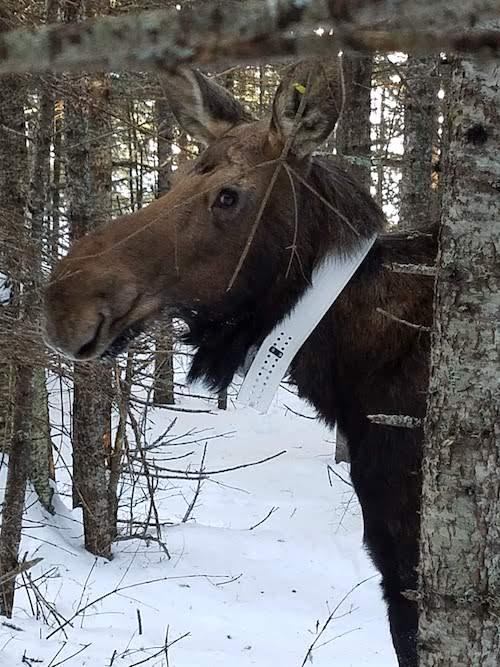
Ten moose have been fitted with radio collars to help researchers more about their behavior/Seth Moore, director of Biology and Environment, Grand Portage Band of Lake Superior Chippewa
How moose at Isle Royale National Park react to the recent influx of wolves could be relatively easy to monitor now that some of the ungulates have been fitted with radio collars.
The collars were placed on 10 cow moose in mid-February by a team from the National Park Service, University of Minnesota College of Veterinary Medicine, Michigan Technological University, and Grand Portage Band of Lake Superior Chippewa. The researchers hope the collars will make it easier to assess population health, effects of herbivory, and impacts of predator restoration to the ecosystem.
“This is the beginning of a novel effort to compare numerous aspects of ecology and the health of the moose population between Isle Royale National Park and the Grand Portage Indian Reservation,” Mark Romanski, Chief of Natural Resources for Isle Royale National Park said. “It also represents an opportunity to evaluate the impacts of restoring predation to the island ecosystem.”
This past weekend saw seven wolves brought to Isle Royale, the latest shipment of a multi-year plan to re-establish a wolf population that could keep the burgeoning moose population, estimated at around 1,500, in check.
"Six wolves that remained on Michipicoten Island, Ontario, and one wolf from mainland Ontario were captured, vet checked, and transported to Isle Royale National Park for release over the last couple of days," the National Parks of Lake Superior Foundation announced on Facebook page.
In recent years, park managers have discussed wolf management on 209-square-mile Isle Royale with wildlife managers and geneticists from across the United States and Canada, and have received input during public meetings and from Native American tribes of the area. Those discussions examined the question of whether wolves should be physically transported to Isle Royale, in large part due to concerns that a loss of the predators would lead to a boom in the moose population that likely would over-browse island vegetation.
Under the plan the National Park Service adopted last year year, up to 30 wolves are to be set free at Isle Royale over the next three to five years in a bid to build genetic diversity into the park's wolf packs. In late February, the Ontario Ministry of Natural Resources and Forestry successfully transferred four wolves to Isle Royale.
The release of seven wolves this past weekend brought the population of predators on Isle Royale to 13. Eight previously had been moved to the park -- four in the fall, and four this winter -- but one died from pneumonia soon after being released and another left the park via ice bridge last month and headed to Minnesota where she had been captured.

A male wolf waiting to be transferred to Isle Royale National Park/OMNRF, J Lethe
The moose collaring project at Isle Royale is the first since 1984. During the collaring operation, a helicopter team, wildlife veterinarian, and wildlife research biologists attached GPS collars to the 10 female moose on both the west and east ends of the island. During capture they also collected biological samples and assessed individual moose health. The moose were alert and able to walk away in under two minutes after being handled by the team. Since then, the research team has been continuously monitoring them by GPS.
The team plans to conduct several studies with this data including understanding differences in the health of island and mainland moose populations, how predator dynamics influence moose populations, how forest management influences moose, and the role of climate on moose and ecosystem health.
Isle Royale’s simple predator-prey system of wolves and primarily moose is ideal for comparative research with the mainland population of moose, also fitted with GPS collars, found on the Grand Portage Indian Reservation. The reservation hosts a more complex ecosystem with multiple predator and prey species. Mainland populations of moose are in decline for numerous reasons: predation from bears and wolves and the effects of changes in climate, such as changes in amount and duration of snow, which has allowed increases in winter ticks as well as parasitism from brain worm as whitetail deer move into moose range.
In contrast to mainland Minnesota, the moose population on Isle Royale has increased rapidly in recent years. Although moose in Isle Royale also suffer from high winter tick loads, brain worm has not made it to the island because of the absence of deer. Another crucial difference is that wolf numbers are high on the mainland (due to high deer densities), whereas until recently on Isle Royale only a few remaining wolves are impacting the moose population. As a result, impact of the growing moose population on forest composition and succession is increasingly apparent and experts are concerned that such high levels of browsing damage are impacting forest regeneration and may eventually lead to nutritional stress for moose.
“The Grand Portage Band of Chippewa were the historical occupants of Isle Royale and used the Island for subsistence purposes.” says Seth Moore, PhD, director of biology and environment at the Grand Portage Band of Chippewa. “We hope to learn how to better manage moose populations from this research.”



 Support Essential Coverage of Essential Places
Support Essential Coverage of Essential Places







Comments
20 gps collars were attached to moose, 10 moose at each end of the Island.